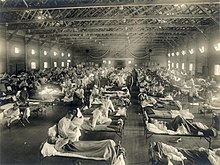Our website is made possible by displaying online advertisements to our visitors.
Please consider supporting us by disabling your ad blocker.
Spanish flu
| Spanish flu | |
|---|---|
 | |
| Disease | Influenza |
| Virus strain | Strains of A/H1N1 |
| Location | Worldwide |
| Date | February 1918 – April 1920[1] |
| Suspected cases‡ | 500 million (estimated)[2] |
Deaths | 25–50 million (generally accepted), other estimates range from 17 to 100 million[3][4][5] |
| ‡Suspected cases have not been confirmed by laboratory tests as being due to this strain, although some other strains may have been ruled out. | |
| Influenza (flu) |
|---|
 |
The 1918–1920 flu pandemic, also known as the Great Influenza epidemic or by the common misnomer Spanish flu, was an exceptionally deadly global influenza pandemic caused by the H1N1 subtype of the influenza A virus. The earliest documented case was March 1918 in the state of Kansas in the United States, with further cases recorded in France, Germany and the United Kingdom in April. Two years later, nearly a third of the global population, or an estimated 500 million people, had been infected in four successive waves. Estimates of deaths range from 17 million to 50 million,[6][7] and possibly as high as 100 million,[8] making it one of the deadliest pandemics in history.
The pandemic broke out near the end of World War I, when wartime censors in the belligerent countries suppressed bad news to maintain morale, but newspapers freely reported the outbreak in neutral Spain, creating a false impression of Spain as the epicenter and leading to the "Spanish flu" misnomer.[9] Limited historical epidemiological data make the pandemic's geographic origin indeterminate, with competing hypotheses on the initial spread.[2]
Most influenza outbreaks disproportionately kill the young and old, with a higher survival rate in-between, but this pandemic had unusually high mortality for young adults.[10] Scientists offer several explanations for the high mortality, including a six-year climate anomaly affecting migration of disease vectors with increased likelihood of spread through bodies of water.[11] However, the claim that young adults had a high mortality during the pandemic has been contested.[12] Malnourishment, overcrowded medical camps and hospitals, and poor hygiene, exacerbated by the war, promoted bacterial superinfection, killing most of the victims after a typically prolonged death bed.[13][14]
The 1918 Spanish flu was the first of three flu pandemics caused by H1N1 influenza A virus; the others being the 1977 Russian flu and the 2009 Swine flu pandemics.[15][16][17]
- ^ Cite error: The named reference
NIH-NYCwas invoked but never defined (see the help page). - ^ a b Taubenberger & Morens 2006.
- ^ "Pandemic Influenza Risk Management WHO Interim Guidance" (PDF). World Health Organization. 2013. p. 25. Archived (PDF) from the original on 21 January 2021. Retrieved 21 August 2021.
- ^ Cite error: The named reference
pmid30202996was invoked but never defined (see the help page). - ^ Rosenwald MS (7 April 2020). "History's deadliest pandemics, from ancient Rome to modern America". The Washington Post. Archived from the original on 7 April 2020. Retrieved 11 April 2020.
- ^ CDC (17 December 2019). "The Discovery and Reconstruction of the 1918 Pandemic Virus". Centers for Disease Control and Prevention. Retrieved 19 September 2022.
- ^ Spreeuwenberg (7 September 2018). "Reassessing the Global Mortality Burden of the 1918 Influenza Pandemic". Our World in Data. 187 (12): 2561–2567. doi:10.1093/aje/kwy191. PMC 7314216. PMID 30202996. Retrieved 17 September 2024.
- ^ Barry JM (2021). The Great Influenza: The Story of the Deadliest Pandemic in History. Penguin Books. pp. 397–398. ISBN 978-0-14-303649-4.
- ^ Cite error: The named reference
Fridaywas invoked but never defined (see the help page). - ^ Gagnon, Miller & et al 2013, p. e69586.
- ^ More AF, Loveluck CP, Clifford H, Handley MJ, Korotkikh EV, Kurbatov AV, et al. (September 2020). "The Impact of a Six-Year Climate Anomaly on the "Spanish Flu" Pandemic and WWI". GeoHealth. 4 (9): e2020GH000277. Bibcode:2020GHeal...4..277M. doi:10.1029/2020GH000277. ISSN 2471-1403. PMC 7513628. PMID 33005839.
- ^ Marshall L (9 October 2023). "1918 flu pandemic myth debunked by skeletal remains". CU Boulder Today. Retrieved 26 March 2024.
- ^ Brundage JF, Shanks GD (December 2007). "What really happened during the 1918 influenza pandemic? The importance of bacterial secondary infections". The Journal of Infectious Diseases. 196 (11): 1717–18, author reply 1718–19. doi:10.1086/522355. PMID 18008258.
- ^ Morens DM, Fauci AS (April 2007). "The 1918 influenza pandemic: insights for the 21st century". The Journal of Infectious Diseases. 195 (7): 1018–1028. doi:10.1086/511989. PMID 17330793.
- ^ "Influenza Pandemic Plan. The Role of WHO and Guidelines for National and Regional Planning" (PDF). World Health Organization. April 1999. pp. 38, 41. Archived (PDF) from the original on 3 December 2020.
- ^ Michaelis M, Doerr HW, Cinatl J (August 2009). "Novel swine-origin influenza A virus in humans: another pandemic knocking at the door". Medical Microbiology and Immunology. 198 (3): 175–183. doi:10.1007/s00430-009-0118-5. PMID 19543913. S2CID 20496301.
- ^ Mermel LA (June 2009). "Swine-origin influenza virus in young age groups". Lancet. 373 (9681): 2108–2109. doi:10.1016/S0140-6736(09)61145-4. PMID 19541030. S2CID 27656702. Archived from the original on 27 July 2021. Retrieved 5 April 2021.
Previous Page Next Page


